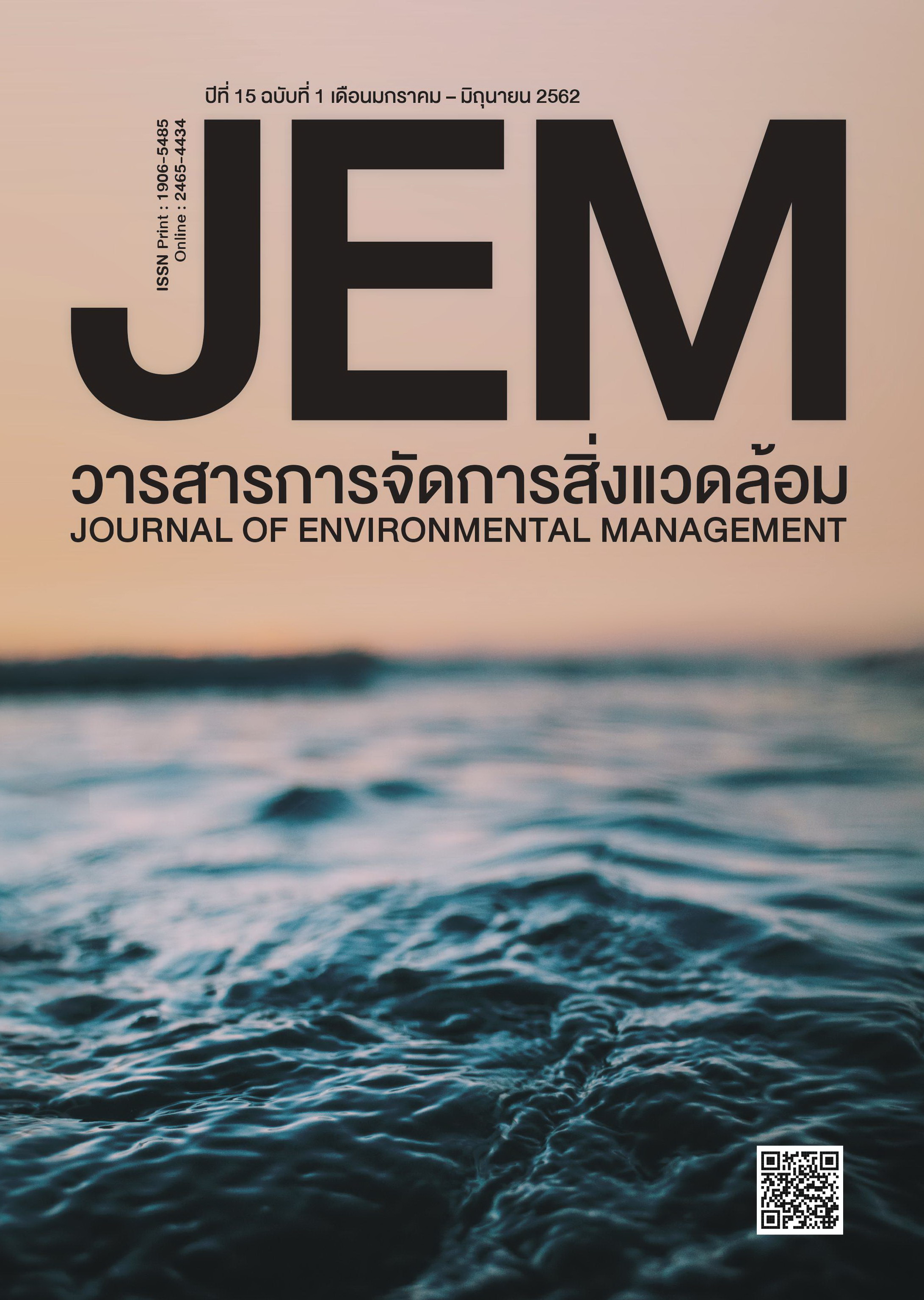เมื่อแหล่งน้ำกลายเป็นสีเขียว: การจัดการฟอสฟอรัสและการฟื้นฟูแหล่งน้ำจืด WHEN THE WATER BECOMES GREEN: PHOSPHORUS MANAGEMENT AND FRESHWATER RESTORATION
DOI:
https://doi.org/10.14456/jem.2019.6คำสำคัญ:
Eutrophication, Floating Treatment Wetlands, Alum application, Phosphorus management, Cyanobacteriaบทคัดย่อ
บทความวิชาการนี้เป็นการทบทวนสาเหตุ ปัญหาและแนวทางป้องกันเพื่อฟื้นฟูแหล่งน้ำจืดที่ประสบปัญหายูโทฟิเคชั่น ซึ่งมีสาเหตุหลักมาจากสารอาหารฟอสฟอรัสที่มากเกิน ฟอสฟอรัสจัดว่าเป็นสารอาหารที่มีบทบาทสำคัญต่อการเกิดยูโทฟิเคชั่นอย่างมากโดยเฉพาะในแหล่งน้ำจืด ซึ่งมาจากแหล่งภายนอก เช่น น้ำท่าชุมชน ฟาร์ม พื้นที่เกษตรกรรม รวมถึงน้ำเสียที่ไม่ผ่านการบำบัด และมาจากแหล่งภายใน ได้แก่ ตะกอนดิน วิธีการแก้ปัญหาต้องคำนึงถึงคือการจัดการสารอาหารฟอสฟอรัสทั้งจากแหล่งภายนอกและภายในสู่แหล่งน้ำจืดร่วมกัน บทความวิชาการนี้จะนำเสนอแนวทางความเป็นไปได้ในการนำมาใช้กับประเทศไทยโดยผ่านการทบทวนทางวรรณกรรม การวิจัยจริงในพื้นที่ที่ประสบปัญหายูโทฟิเคชั่นในจังหวัดขอนแก่น และการศึกษาดูงานที่ประเทศสหรัฐอเมริกา ประกอบด้วย การใช้แผนการจัดการสารอาหาร ภายใต้พระราชบัญญัติ รัฐเพนซิลวาเนีย 38 แนวทางการป้องกันการพังทลายของหน้าดิน การทำการเกษตรแบบไม่ไถพรวน การหมักปุ๋ยแบบร่วม การบำบัดน้ำเสียโดยใช้ถังปฏิกรณ์แบบแนวตั้ง การใช้สารส้มและการทำบึงประดิษฐ์แบบลอยน้ำ เป็นต้น
เอกสารอ้างอิง
Chesapeake Bay Program. (2019). Watershed. Retrieved on 3 January 2019 from https://www.chesapeakebay.net/discover/watershed.
Creech, E. (2017) Blog post: Saving Money, Time and Soil: The Economics of No-Till Farming. Retrieved on January 2019 from United States Department of Agriculture (USDA) (2019) https://www.usda.gov/media/blog/2017/11/30/saving-money-time-and-soil-economics-no-till-farming.
Dunne, E.J., and Reddy, K.R. (2005). Phosphorus biogeochemistry of wetlands in agricultural watersheds. Chapter in Dunne, E.J., K.R. Reddy and O.T. Carton. (eds.). 2005. Nutrient management in agricultural watersheds: A wetlands solution. Wageningen Academic Publishers. pp. 105-119.
Fan, C., Zhang, L., Qin, B. et al. (2004). Estimation on dynamic release of phosphorus from wind-induced suspended particulate matter in Lake Taihu. Science in China Series D: Earth Sciences; 47: 8, 710–719. https://doi.org/10.1360/02yd0438
Hupfer, M., Gächter, R., and Giovanoli, R. (1995) Transformation of phosphorus species in settling seston and during early sediment diagenesis. Aquatic Sciences, 57(4), 305.
Noyma, N.P., et al. (2016). Controlling cyanobacterial blooms through effectiveflocculation and sedimentation withcombined use offlocculants and phosphorus adsorbing natural soil and modified clay. Water Research 97, 26-38. https://dx.doi.org/10.1016/j.watres.2015.11.057
Pavlineri, N., Skoulikidis, N.T., and Tsihrintzis, V. A. (2017). Constructed Floating Wetlands: A review of research, design, operation and management aspects, and data meta-analysis, Chemical Engineering Journal, 308, 1120-1132.
Paerl H., Xu H., McCarthy M., Zhu G., Qin B., Li Y. and Gardner, W. (2011). Controlling harmful cyanobacteria blooms in a hyper-eutrophic lake (Lake Taihu, China): the need for a dual nutrient (N&P) management strategy. Water Research 45(5), 1973-83.
Psenner, R., Boström, B., Dinka, M., Pettersson, K., Puckso, R., and Sager, M. (1988) Fractionation of phosphorus in suspended matter and sediment. Archiv für Hydrobiologie, Supplement, 30, 98–103.
Schneider, F. (2019). Nutrient Management Program. Pennsylvania Department of Agriculture Retrieved on June 2018 from
https://www.agriculture.pa.gov/Plants_Land_Water/StateConservationCommission/NutrientManagementProgram/Pages/default.aspx
Sánchez-Carrillo, S., Alatorre, L.C., Sánchez-Andrés, R. et al. (2007). Eutrophication and Sedimentation Patterns in Complete Exploitation of Water Resources Scenarios: An Example from Northwestern Semi-arid Mexico. Environ Monit Assess 132: 377. https://doi.org/10.1007/s10661-006-9541-x
United States Environmental Protection Agency (US EPA). (1996). Managing Urban Runoff in Nonpoint Pointers: Managing Urban Runoff, Pointer No. 7
United States Environmental Protection Agency (US EPA). (2017). Biosolids. Retrieved on Feb 2019 from https://www.epa.gov/biosolids
United States Department of Agriculture (USDA) (2018). Natural Resources Conservation Service. Report: Chesapeake Bay Watershed Action Plan. Retrieved on January 2019 from https://www.nrcs.usda.gov/Internet/FSE_MEDIA/nrcseprd1415210.pdf
Vymazal J. (2007). Removal of nutrients in various types of constructed wetlands. Science of The Total Environment 380(1-3), 48-65.
Wang C.-Y., Sample D. J. and Bell C. (2014). Vegetation effects on floating treatment wetland nutrient removal and harvesting strategies in urban stormwater ponds. Science of The Total Environment 499, 384-93.
Wang C.-Y., Sample D. J., Day S. D. and Grizzard T. J. (2015). Floating treatment wetland nutrient removal through vegetation harvest and observations from a field study. Ecological Engineering 78, 15-26.
World Health Organization, Geneva. (1998). Guidelines for drinking-water quality, 2nd ed. Addendum to Vol. 2. Health criteria and other supporting information. Retrieved on January 2019 from https://www.who.int/water_sanitation_health/water-quality/guidelines/chemicals/cyanobactoxins.pdf?ua=1
Xu H., Paerl H., Qin B., Zhu G. and Gao G. (2010). Nitrogen and phosphorus inputs control phytoplankton growth in eutrophic Lake Taihu, China. Limnology and Oceanography 55(1), 420-3.
Zamparas M. and Zacharias I. (2014). Restoration of eutrophic freshwater by managing internal nutrients: A Review. Science of The Total Environment 496, 551-62.
Zhu L., Li Z. and Ketola, T. (2011). Biomass accumulations and nutrient uptake of plants cultivated on artificial floating beds in China's rural area. Ecological Engineering 37(10), 1460-6.



